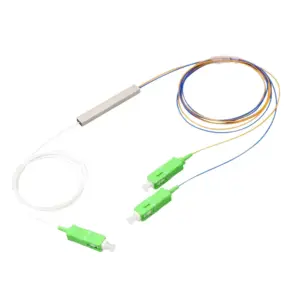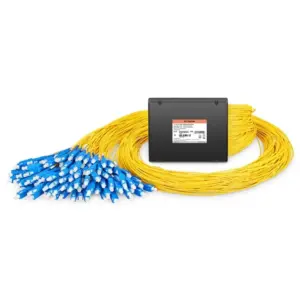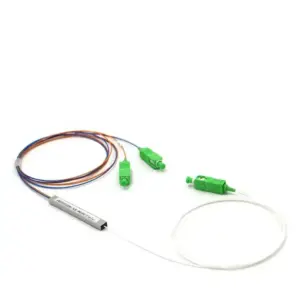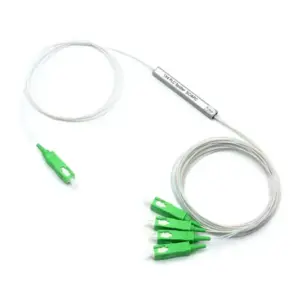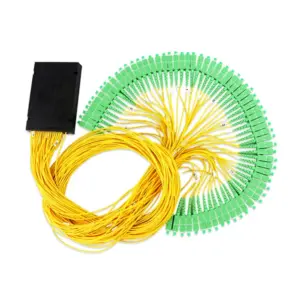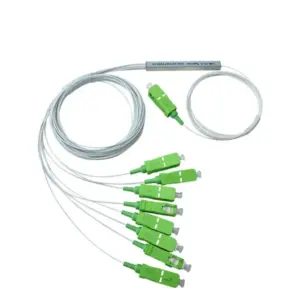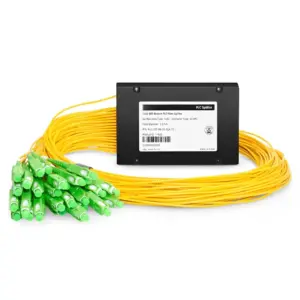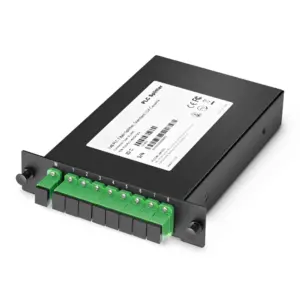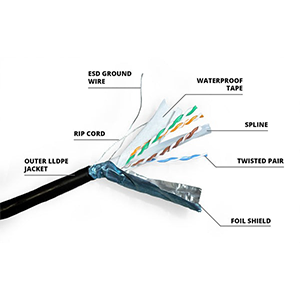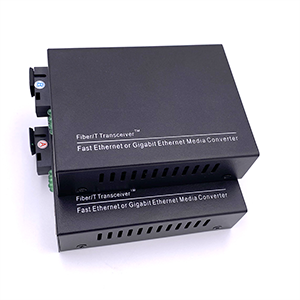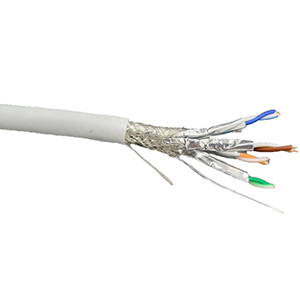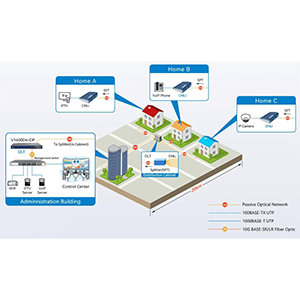In this article, I will take you to have an in-depth understanding of the basic concepts and definitions of 1×2 plc fiber splitter, explain what 1×2 represents and its important role in optical communications. We will conduct an in-depth analysis of the working principle and structure of the 1×2 PLC optical fiber splitter, revealing its internal mechanism and key design of optical signal distribution. Discuss the technical advantages of 1×2 PLC optical fiber splitter compared to traditional optical splitters, as well as its low loss and high stability in optical signal transmission.
1. Introduction to 1×2 plc fiber splitter
1. Basic concepts and definitions:
1×2 indicates the port configuration of the optical fiber splitter. Among them, the number “1” means there is only one input port, and “2” means there are two output ports. Therefore, the 1×2 PLC fiber optic splitter has a structure of one input port and two output ports.
2. The meaning of 1×2 and its role in optical communications:
-
The meaning of 1×2: 1×2 means that the optical signal enters from one input port and is then distributed to two output ports. This structure enables optical signals to be distributed to different destinations or receiving devices, realizing the distribution and sharing of optical signals.
-
Role in optical communications: 1×2 PLC fiber optic splitter plays an important role in optical communication systems and is mainly used to distribute optical signals to multiple receiving devices or fiber optic channels. For example, in an optical network, a 1×2 optical splitter can distribute optical signals from the central office to different user terminals or different network nodes.
The design and functionality of the 1×2 PLC fiber optic splitter make it one of the indispensable key components in optical communication systems, providing an effective solution for the distribution and transmission of optical signals.
2. Working principle and structure of 1×2 plc fiber splitter
1. Internal structure and components:
-
Planar waveguide chip: It is the core component of the 1×2 optical fiber splitter, usually made of silicon-based or silicon-based nitride and other materials. Planar waveguide chips have precisely carved optical waveguide structures that guide and distribute optical signals.
-
Input optical fiber port: The optical signal is transmitted from the optical fiber network to the input port of the 1×2 optical splitter.
-
Output fiber port: the output port of the 1×2 optical splitter. After the optical signal is processed by the optical splitter, it is distributed to different output ports.
-
Coupler: Located inside the planar waveguide chip, it is used to distribute the input optical signals to different waveguide channels. In the case of 1×2, the coupler distributes the incoming optical signal to the two output ports.
2. Working principle:
-
Optical signal introduction: The optical signal is introduced into the optical fiber splitter through the input optical fiber port.
-
Coupler distribution: After the optical signal enters the planar waveguide chip, it is distributed through the coupler. Couplers are designed to distribute optical signals to one of two output channels.
-
Optical signal distribution: Inside the planar waveguide chip, the optical signal is transmitted along the designed optical path. According to the design of the waveguide, the optical signal is distributed to an output port.
-
Output optical signal: The distributed optical signal is output through the corresponding output optical fiber port and transmitted to the target device or network node.
The design of the 1×2 PLC fiber optic splitter enables optical signals to be distributed to different destinations to meet the distribution needs in optical communication systems. Through precise optical design and manufacturing processes, 1×2 optical splitters can efficiently distribute and process optical signals, providing important functional support for optical communication systems.
3. 1×2 plc fiber splitter technical features and advantages
1. Technical advantages compared to traditional spectrometers:
-
Compact package: 1×2 PLC fiber splitter is usually manufactured using planar waveguide technology, has a compact package structure, takes up little space, and is suitable for high-density integration applications.
-
Low loss: 1×2 PLC fiber optic splitters typically have lower insertion loss than traditional splitters. The use of advanced manufacturing processes and materials effectively reduces the energy loss of optical signals during transmission.
-
High stability: 1×2 PLC fiber optic splitter has excellent temperature stability and long-term stability, and is suitable for various working environments. Its optical properties are not easily affected by temperature changes and mechanical vibration, ensuring the stability of signal transmission.
-
High splitting ratio: 1×2 PLC optical fiber splitter can achieve a higher splitting ratio, that is, the input optical signal is distributed to different output channels according to a preset ratio to meet the needs of different application scenarios.
2. Advantages in optical signal transmission:
-
Low loss: 1×2 PLC fiber optic splitter adopts high-quality optical materials and precision processing technology, with low insertion loss, which can maintain the intensity and quality of optical signals and reduce energy loss during signal transmission.
-
High stability: The optical performance of the 1×2 PLC fiber optic splitter is stable, not affected by temperature and mechanical vibration, and works stably and reliably for a long time. This stability ensures the reliability of optical signal transmission and is suitable for applications in various complex environments and working conditions.
To sum up, the 1×2 PLC optical fiber splitter has technical advantages such as lower loss, higher stability and more compact packaging than traditional optical splitters, and has broad application prospects in optical communications and network systems. .
IV. 1×2 plc fiber splitter application scenarios and cases
1×2 PLC optical fiber splitter has a variety of typical application scenarios in optical networks. The following are some common application cases:
-
Fiber access network (FTTx): In fiber-to-the-home (FTTH), fiber-to-the-building (FTTB) and other access networks, 1×2 PLC fiber optic splitter is used to distribute optical signals to different user terminals or buildings.
-
Fiber optic sensing network: 1×2 PLC fiber optic splitter plays an important role in the fiber optic sensing network. It is used to distribute optical signals to different sensing units and monitor physical quantities such as temperature, pressure, strain, etc.
-
Data center: In the optical interconnection of the data center, 1×2 PLC optical fiber splitter is used to realize data distribution and integration, improving the efficiency and reliability of data transmission.
-
Cable TV network: In the cable TV network, 1×2 PLC optical fiber splitter is used to distribute optical signals to different user terminals to realize the transmission and distribution of cable TV signals.
1×2 PLC optical fiber splitter demonstrates its important role and value in optical communication systems through actual cases, providing reliable optical distribution solutions for the construction and operation of optical networks.
5. Future development trend of 1×2 plc fiber splitter
1×2 PLC optical fiber splitter is one of the key components in the field of optical communications. Its future development direction and innovation trends mainly include the following aspects:
1. Higher performance and lower loss:
-
High-performance requirements: With the development of optical communication technology, the performance requirements for 1×2 PLC optical fiber splitters are constantly increasing. The future development direction will pay more attention to the performance optimization and improvement of devices.
-
Low loss requirements: 1×2 PLC optical fiber splitter needs to continuously reduce insertion loss and improve the transmission efficiency and stability of optical signals to meet the needs of high-speed and large-capacity optical communication systems.
2. Miniaturization and integration:
-
Miniaturization trend: Future 1×2 PLC optical fiber splitters will tend to be miniaturized and integrated, achieving smaller size and higher integration devices to meet the needs of dense integration and high-density layout.
-
Integrated multi-functional devices: 1×2 PLC optical fiber splitter may integrate other functional modules, such as optical modulators, optical switches, etc., to achieve multi-functional integration and improve the overall performance and flexibility of the device.
3. Multi-wavelength support and wide wavelength range:
-
Multi-wavelength technology: Future 1×2 PLC optical fiber splitters will pay more attention to supporting multi-wavelength optical signal distribution to meet the needs of multi-wavelength optical communication systems such as dense wavelength division multiplexing (DWDM).
-
Wide wavelength range: 1×2 PLC optical fiber splitter needs to support optical signal distribution within a wider wavelength range to meet the needs of optical communication systems and optical networks of different wavelengths.
4. New materials and manufacturing processes:
-
New material applications: Future 1×2 PLC optical fiber splitters may use new materials, such as silicon-based photonics materials, silicon nitride, etc., to improve the performance and reliability of the device.
-
Advanced manufacturing technology: New manufacturing technology and processing technology will continue to be applied in the manufacturing of 1×2 PLC fiber optic splitters to achieve more precise device structures and more efficient production processes.
To sum up, in the future, 1×2 PLC fiber optic splitters will continue to innovate and develop in terms of performance, miniaturization, and multi-wavelength support to meet the growing needs of the optical communication market and promote the progress and development of optical communication technology.
Summary:
1×2 PLC optical fiber splitter is a new force in optical communication technology, injecting new vitality and power into optical signal transmission. Its technical advantages and important role in optical networks make it a leader in the industry.
When you choose our 1×2 plc fiber splitter, you not only gain the leading edge of technology, but also get the support and service of a professional team. Let us work together to create a brilliant future for optical communications and inject new vitality and power into your business and projects!
-
128-channel optical fiber PLC splitter
-
16-channel optical fiber PLC splitter
-
2-way optical fiber PLC splitter
-
32-channel optical fiber PLC splitter
-
4-way optical fiber PLC splitter
-
64-channel optical fiber PLC splitter
-
8-channel optical fiber PLC splitter
-
ABS module PLC fiber optic splitter
-
Box PLC optical fiber splitter

